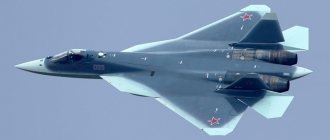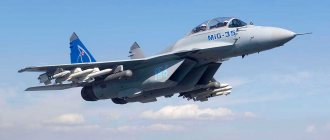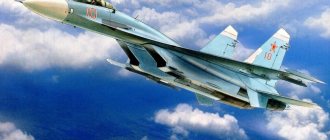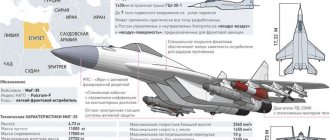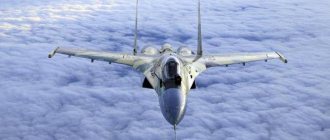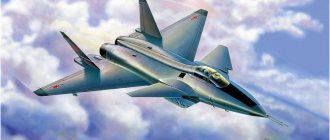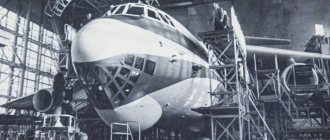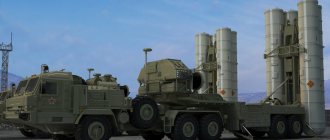At the MAKS-2019 air show, the general public was able to see the domestic fifth-generation fighter Su-57 for the first time. The group of aircraft amazed the audience with the most difficult piloting, and at the static exhibition, guests had the opportunity to examine the newest fighter up close. During the show, the export version of the Su-57E was presented, which attracted interest from foreign delegates.
In 2022, serial production of the Su-57 began. This is, without a doubt, a new era in the development of Russian military aviation. With the start of deliveries of the Su-57 for the Aerospace Forces, Russia is joining the elite community of countries that own fifth-generation combat aircraft. About the history of creation and features of the Su-57 - in our material.
History of creation
The PAK FA T-50, or the advanced front-line aviation complex, is a prototype of the domestic fighter of the latest fifth generation Su-57, developed by the Sukhoi Design Bureau. For 2022, several test samples of the machine with the first stage engine are known. However, a more advanced engine has already been developed, which will be installed on production aircraft in 5–7 years.
Work on creating a fifth-generation fighter began in 2001, when Rosaviakosmos and the Ministry of Defense developed a joint program to develop the latest aircraft. Development work was entrusted to the State Unitary Enterprise "APVK Sukhoi". It was planned that serial production and large-scale delivery of the aircraft to Russian troops would begin in full by 2015, however, for unknown reasons, there were significant delays in the development of the aircraft, which is why, among other things, India withdrew from the program for financing and purchasing aircraft of this project.
Projections of PAK FA T-50-1. Drawing.
Many foreign experts regarded this step as a potential failure of the program to develop the latest generation fighter. However, the fate of the Su-57 today promises to be very promising. According to V.V. Putin, who very highly assessed the prospects of the new fighter, domestically produced serial aircraft will cost the army at least half as much as foreign ones, and therefore a decision was made to continue development.
Considering the novelty of the development, the name of the chief designer, as well as many of the technical characteristics of the machine, are unknown today.
The first tests of the Su-57 aircraft (then T-50) took place at the beginning of 2010. The flight lasting 45 minutes was carried out by Honored Test Pilot Sergei Bogdan. The following year, the test vehicle broke the sound barrier after 40 test flights at subsonic speeds.
In February 2022, 4 Su-57 aircraft were delivered to Syria to test the aircraft’s capabilities in combat conditions. In the skies over the province of Latakia, it was planned to study the weapon system, on-board equipment, as well as the degree of detection by enemy aircraft.
Airplane for the future
Until recently, only the US Air Force could boast of full-fledged production models of fifth-generation fighters. The United States has been commercially supplying two models to the military: the F-22 since 2005 and the F-35A/B since 2015. The Chinese J-20 aircraft, although officially put into service in 2022, is still in the status of a pre-production model.
The appearance of the Su-57 caused predictable criticism and accusations that the fighter did not meet the criteria of the fifth generation from NATO and US specialists. It is based on the reluctance of competitors to share global arms markets. The opinions of Western experts are based on differences in the requirements for the new generation of aircraft. American fighters, saturated with modern electronics and made with an emphasis on stealth technology, turned out to be very expensive. The Su-57, while almost fully consistent with the Western understanding of the fifth generation, was much more maneuverable and, importantly, not as expensive as its American counterparts.
Photo: MAKS air show organizing committee
In 2022, the Su-57 fighter gained experience in conducting real combat operations in Syria and confirmed its declared high performance. However, the military is in no hurry to purchase a new fighter en masse, since the previous Su-35 model meets most current requirements and is considered one of the best combat aircraft in the world. Nevertheless, in May 2022, Vladimir Putin gave instructions to transfer three aviation regiments to new aircraft by 2028, and already in June an agreement was signed between the Ministry of Defense and the Ministry of Defense for the supply of 76 fifth-generation fighters. Production of the Su-57 was launched at the Yu.A. Aviation Plant. Gagarin in Komsomolsk-on-Amur.
At the international air show MAKS-2019, forum participants and guests were able to see the newest fighter up close for the first time. The static exhibition featured the export version of the Su-57E, the supply of which was of interest to the President of Turkey and representatives of China and India.
Export Su-57E at MAKS-2109. Photo: Alexander Utkin
The implementation of such a global project as the PAK FA could only take place in close cooperation of the entire defense-industrial complex. Rostec holdings and UAC enterprises have done a tremendous amount of work, which has provided the foundation for the development of the Russian aviation industry for many years. In addition to such obvious results as building up the country’s military power and growing export opportunities, the latest developments and technologies obtained in the process of creating a fifth-generation fighter will certainly enrich the field of civil aircraft construction.
Characteristics of the Su-57
The characteristics of the Su-57 can be judged very conditionally, since there is no data on models with updated second-stage engines. It is known that the aircraft has a length of 19.4 m and a wingspan of 14 m. In addition, the sweep angle has been increased compared to its predecessors: 48°.
The empty weight of the aircraft is estimated at 18.5 tons, the maximum take-off weight is 35.5 tons. With 63% fuel (normal load), the aircraft is capable of flying 2,700 km at cruising speed and 1,200 km at supersonic without afterburning. The maximum speed of the Su-57 at altitude reaches Mach 2.45, the maximum without afterburner is Mach 2. The height ceiling is 20 km.
Design
The PAK FA drawing is currently strictly classified. The properties of the new military machine can only be judged from open sources. It is known that the Su-57 belongs to the class of heavy fighters, is multifunctional, has high maneuverability and supersonic cruising speed. Also, the new domestic aircraft is inconspicuous thanks to stealth and electronic warfare technologies.
Cabin
The cabin of the Su-57 is designed for one person, but its space is wider than that of the Su-27 due to the design of the airframe. There is an oxygen generator inside the cabin. The information display system is complemented by displaying information on the pilot's helmet glass.
The cockpit canopy is covered with a radio-absorbing compound. It is reported that now its configuration is not final and will undergo changes during mass production. The digital computer takes into account the pilot’s parameters, including height and weight, optimizing the maneuvers and control of the aircraft for them.
For serial production, the designers promise to develop a new life support system, equipment and oxygen system.
Glider
The PAK FA airframe is made according to a normal aerodynamic design and is of an integral type. The shape of the airframe is largely determined by visibility reduction technologies, which is necessary for a fifth-generation fighter. The weight of the body has been reduced through the use of composites: a quarter of the empty weight of the aircraft and 70% of its surface are composites. In addition, the Su-57 has 4 times fewer parts compared to the Su-27, which reduces the time and complexity of assembling the product.
Do you believe that the Su-57 is the future?1
Not really
Engines
The first samples of the Su-57, its prototype, as well as previous models were equipped with AL-41F1 engines, allowing them to reach supersonic speed without the aid of afterburner. This engine had improved fuel consumption characteristics, a fully digital control system, and increased traction force.
However, in the future it is planned to install a new engine for the Su-57, which is currently called “Product 30”, and in the future will receive the index “AL”. This is a completely new engine, with a new fan, control system and hot end. According to a representative of the developers, this engine has no analogues in the world and is capable of not only improving the flight characteristics of the vehicle, but also reducing its visibility.
Avionics
According to the general director of NIIP, the PAK FA radio-electronic system will be fundamentally different from similar systems in the usual sense. The innovative effect will be achieved thanks to a network of active and passive radio and optical location systems that make up the “smart skin” of the aircraft.
It is planned to install an optical-location system on serial Su-57s, which will effectively detect the enemy both in the front and rear hemispheres relative to the aircraft, protect the vehicle from solar erosion, and also reduce the effective scattering area (RCS), which will reduce the visibility of the aircraft.
A new radar, Belka, is being designed for use on the Su-57, since the previous Irbis model cannot be installed on this aircraft model due to inconsistency with the dimensions. A prototype of this system was first demonstrated in 2009.
Stealth
During the development of the PAK FA, aircraft designers were especially puzzled by technologies for reducing visibility, since this is the main requirement for fifth-generation fighters. This term refers to a set of measures to reduce the likelihood of detecting an aircraft in various wave ranges, including acoustically.
In the Su-57 project, stealth for radio waves is achieved thanks to the shape and coating of the aircraft's airframe, as well as electronic warfare equipment. In particular, the design eliminates the mutual arrangement of surfaces at right angles, which eliminates the effect of a corner reflector.
In addition, some of the weapons are located in the internal compartments of the aircraft to reduce radio signature. For visual camouflage, camouflage coloring of the airframe is used. The first Su-57 had a winter deformation color - this means that the protruding parts of the aircraft were painted in dark spots, and the rest - in a light color, which visually deformed the outline of the aircraft in the visible range.
Thermal and sound signatures have been reduced thanks to the new design of the aircraft's engines. The PAK FA also uses a system of passive sensors that allow it to receive information about enemy positions without giving itself away as signals.
Fighter weapons
The armament of the Su-57 allows the PAK FA fighter to be called a universal fighter, capable of hitting both ground and air targets. The maximum combat load of the Russian fifth-generation fighter is 10 tons. The projectiles are located on 16 suspension points: eight internal and eight external. For air combat, air-to-air missiles can be located in the main weapon compartments:
- up to 6 medium range;
- up to 4 short range.
The following weapons are provided against ground targets:
- up to 4 KAB-500, adjustable bombs;
- up to 4 X-38, high-precision missiles;
- up to 2 X-58, anti-location missiles.
In addition, new types of weapons are being developed for production Su-57s, which will be supplied along with newly produced aircraft for service in the Air Force.
Stealth, electronic warfare, radar
The key property of a fifth-generation fighter is radar invisibility, or, more precisely, stealth. No one has yet achieved absolute invisibility, but it can certainly be significantly reduced. Stealth is ensured by a whole range of measures. First of all, it is the shape of the airframe, which allows maximum dispersion of radar radiation, as well as a radio-absorbing coating. In this regard, the Su 57 is at the forefront, roughly matching the performance of the F-22 and clearly superior to the F-35. However, real stealth on the Russian fighter is ensured largely due to the Himalaya electronic warfare system, which is noticeably ahead of the best American analogues. The same superiority is possessed by the Belka radar, installed on an aircraft and capable of detecting the enemy in both the centimeter and decimeter ranges, providing all-angle visibility. Dicimeter-range locators, although inferior in accuracy to centimeter-range systems, nullify the “invisibility” of American stealth fighters. The most important means of detecting the enemy is the Atoll electro-optical system, which allows monitoring airspace in the visible range. There is no such system on American fighters. It is important to note that the detection range of the Belka radar significantly exceeds that of potential enemy vehicles.
Considering the total capabilities of electronic detection and suppression systems in combination with super-maneuverability and the most advanced weapons, the Su 57 fighter has no equal.
It should be noted that the characteristics given here are approximate, taken from open sources, since the exact data is naturally not disclosed.
Cost of Su-57
Due to the fact that serial deliveries of the PAK FA to the Air Force have not yet begun, the cost of purchasing these aircraft has not yet been disclosed to the general public. What is clear is that the cost of the Su-57 for the Russian army will be significantly lower than for foreign buyers.
Based on the price of its closest analogues, we can say that the price of a domestic innovative fighter will be approximately 120–150 million dollars per unit. Thus, the closest in concept is the fifth generation American F-22, which is supplied at a price of $150 million per aircraft.
Export modification
The version of the Su-57 for delivery to other countries (first of all, deliveries to India were planned) was called FGFA. India, together with the United Aircraft Corporation, sponsored the development of the PAK FA and partially took part in it.
However, in 2022, the Indian side withdrew from the project, explaining that the declared characteristics of the future aircraft do not correspond to the actual ones, and also that many of the systems of the projected aircraft do not correspond to the parameters of the fifth generation. At the moment, the potential importing country of the Su-57 is Peru.
Contracts for supplies to troops, mass production
On August 22, 2022, at the Army-2018 forum, the Russian Ministry of Defense and Sukhoi PJSC signed a contract for the supply of two production copies of the Su-57 by 2022. On the same day, Deputy Minister of Defense of the Russian Federation Alexei Krivoruchko told reporters that the first production aircraft “will come to the Armed Forces next year.” UAC head Yuri Slyusar said at the forum that the Su-57 will become the basis for a whole family of aircraft.
On December 6, 2022, a TASS source in the aircraft industry reported that the Su-57 will receive a hypersonic missile with characteristics similar to the Kinzhal missile; the corresponding work has been included in the state armament program for 2018-2027. According to the source, the missile will be internally mounted and smaller in size.
On May 15, 2022, Russian President Vladimir Putin announced at a meeting on defense topics that 76 Su-57 aircraft would be purchased by 2028. He explained that previously the arms program planned to purchase 16 such aircraft until 2028, but manufacturers were able to reduce the cost of both aircraft and weapons by 20%, as a result of which it became possible to purchase more combat vehicles of this class. The signing of the corresponding contract became known on June 27, 2022 at the International Military-Technical Forum “Army-2019”.
On July 29, 2022, the office of Deputy Prime Minister Yuri Borisov announced that serial production of the Su-57 had begun. On August 12, 2019, Air Force Commander - Deputy Commander-in-Chief of the Aerospace Forces Sergei Dronov told the Krasnaya Zvezda newspaper that state tests of the fighter would be completed in 2022. On December 18, Chief of the General Staff Valery Gerasimov, speaking to foreign military attaches, said that the Su-57 had been retested in Syria.
As of December 2022, at least three prototypes for ground (static) testing and at least ten flight prototypes have been manufactured. One of them, T-50-5, was damaged on June 10, 2014 as a result of a fire in Zhukovsky near Moscow (the fire was quickly extinguished, and the aircraft was subsequently restored).

